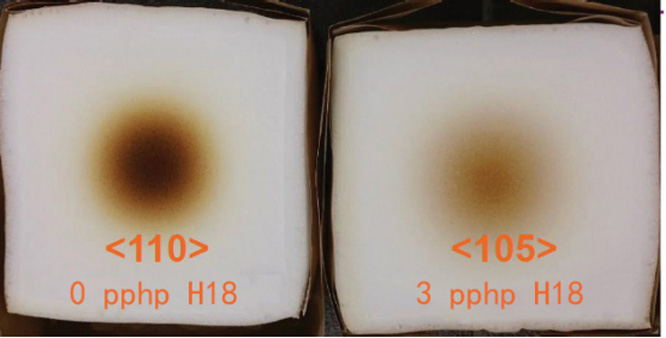New generation sponge hardener
In the production of polyurethane block sponges, adjusting the hardness of the sponge has always been a difficult problem. The sponge hardness can be adjusted by different methods. Generally, reducing the hardness of the sponge, that is, softening the sponge, does not change the other properties of the sponge much, but it is impossible to increase the hardness of the sponge without adversely affecting other properties of the sponge.
There are many ways to increase the hardness of the sponge. The first thought is to increase the hardness of the sponge by increasing the density of the sponge. For every 1 kg/m3 of sponge density, the hardness can be increased by about 1.0 kPa (CLD 40%), but this will increase the cost; using filler materials (CaCO3 and BaSO4) can also Increase the hardness, but this method is not permanent and will reduce the physical properties of the sponge; there is also a common method is to add polymer polyols, this method can increase the hardness, but the cost of the sponge will be greatly increased; a This method is to strengthen the three-dimensional structure of the sponge, that is, to increase the number of cross-links, which can be achieved by increasing the TDI index. However, this method will change the foam cell structure of the sponge, reduce the permeability and increase the number of closed cells. In addition, as the reaction temperature increases, the risk of yellowing or even ignition in the block increases; another method is to accelerate the gelation reaction, that is, increase the tin catalyst. This method will also change the cell structure of the sponge and reduce the permeability.
According to industry needs, Xindian Chemical has conducted a long-term study on the hardness mechanism of sponges. As a result of these studies, the newly developed sponge-specific hardening additive series meets customer needs. The following table is a list of the products of Xindian Chemical:
NT H12 NT H15 NT H18
Type Amine Reactive Hardener Polyester Hardener Polyether Hardener
Advantages and Disadvantages The product itself has an ammonia odor, can participate in the reaction, has no VOC emissions, and is miscible with the combination material system. No formula adjustment is required, and the amount of addition is small. It can participate in the reaction and has poor compatibility with the composite material system. It can reduce the TDI index to save costs and is cheap. It can participate in the reaction, can be miscible with the combination material system, can reduce the TDI index and save costs, the amount of addition is large, and the comprehensive cost performance is high.
Taking NT H18 as an example, specific experiments show its performance and effect.
Unlike other hardening additives on the market, NT H18 can significantly increase the hardness without affecting the foam cell structure. When NT H18 is added to the formulation, there is no need to change the amount of TDI or tin to maintain the open-cell structure. The amount used is 1 to 5 pphp, depending on the required hardness increase. Depending on foam density, formulation and production parameters, the hardness can be increased by 35% without significantly changing the pore structure.
Table 1: The general formula of the foam of the experiment box with a foam density of 16kg/m3 is as follows:
Polyol OHN 48 (pphp) 100-X
Total water (pphp) 5.2
NT CAT A-33 (pphp) 0.15
NT CAT T-9 (pphp) 0.25
Tegostab B8160 (pphp) 1.3
Methylene Chloride (pphp) 7.5
NT H18 (pphp) X
TDI Index 110
As shown in Figure 1, under the reference formulation laboratory conditions, the density of 16kg/m3 sponge added 3pphp and 5pphp NT H18, its hardness increased by 25% and 35%.
Figure 1: The hardness change curve of NT H18 sponge with 3pphp and 5pphp added

NT H18 can be used not only to increase hardness, but also to reduce the content of TDI, polymerized polyol or tin in the formulation while maintaining sponge hardness. Therefore, if necessary, it can be used to reduce costs and promote process conditions (reaction temperature). As shown in Table 2, under the reference formula laboratory conditions, adding 3pphp of NT H18 to a 21kg/m3 sponge reduces the TDI index from 105 to 100, the hardness remains almost constant, and the sponge yellowing problem can be significantly improved , As shown in Figure 2.
Table 2: The general formula of the sponge with a density of 21kg/m3 in the experiment box is as follows:
Polyol OHN 48 (pphp) 100 97
Total water (pphp) 4.8 4.8
NT CAT A-33 (pphp) 0.20 0.20
NT CAT T-9 (pphp) 0.22 0.22
Tegostab B8232 (pphp) 1.0 1.0
TDCPP (pphp) 10 10
NT H18 (pphp) 0 3
TDI Index 110 105
Figure 2: Comparison of the yellowing results of the sponge obtained in the experiment

Summary: Based on the above experimental results, it can be concluded that NT H18 can significantly improve the hardness of the sponge without affecting the other physical properties of the sponge itself, and can improve the yellowing problem of the sponge to a certain extent.


